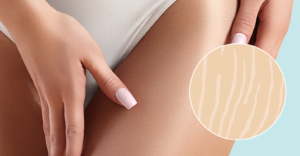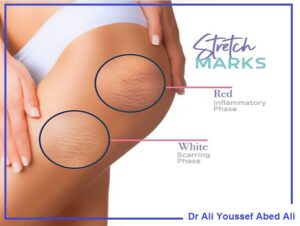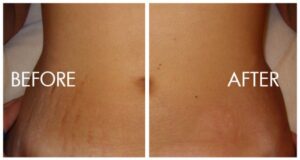
What are stretch marks?
Stretch marks are lines or bands caused by stretching of the skin’s connective tissue.
When the middle layer of skin stretches too quickly, some of its collagen fibers can break.
This allows underlying blood vessels to show through, leaving behind the telltale red or purplish marks.
Over time, they fade to a white or silver color as blood vessels heal. Once they appear, the marks do not usually go away fully.
Stretch marks are not physically painful, but they can affect a person’s confidence and self-esteem. They can be disfiguring in severe cases.
Experts have tried for years to find an effective treatment for these marks.
Unfortunately, no treatment has been shown to erase them fully. New ways of treating stretch marks are emerging, however, and some of them show promise.

LASER TREATMENT
Laser therapy is one of the newest treatments for stretch marks that appears to be effective in reducing their appearance.
Pulsed dye lasers and intense pulsed light can improve the appearance of stretch marks and increase collagen production over time.
A person may need up to 20 treatments to see a 20- to 60-percent improvement in their stretch marks. Treatment can be costly.
Platelet-rich plasma with ultrasound TREATMENT
Platelet-rich plasma (PRP) therapy has gained popularity as a way to revive skin and increase collagen production. PRP therapy uses platelet-rich plasma taken from the person’s own blood immediately before the procedure.
A study in the Journal of Cosmetic and Laser Therapy indicates that PRP therapy coupled with an ultrasound device may be a good treatment for reducing stretch marks.
More than 70 percent of participants reported “good” or “very good” improvement in their appearance.
Plastic surgery
A tummy tuck, thigh lift, and other similar procedures work by removing excess skin and tightening remaining skin and tissue.
A doctor or healthcare professional may suggest that people who have sagging skin due to weight loss or pregnancy have these procedures.
According to the American Society of Plastic Surgeons, the ideal candidate for this surgery:
- has a stable weight and good health
- does not smoke
- has realistic expectations about what the surgery can do
These procedures are not specifically designed to remove stretch marks. However, loss of the stretch marks — due to the removal of the excess skin from the body — marks can be an added benefit.


